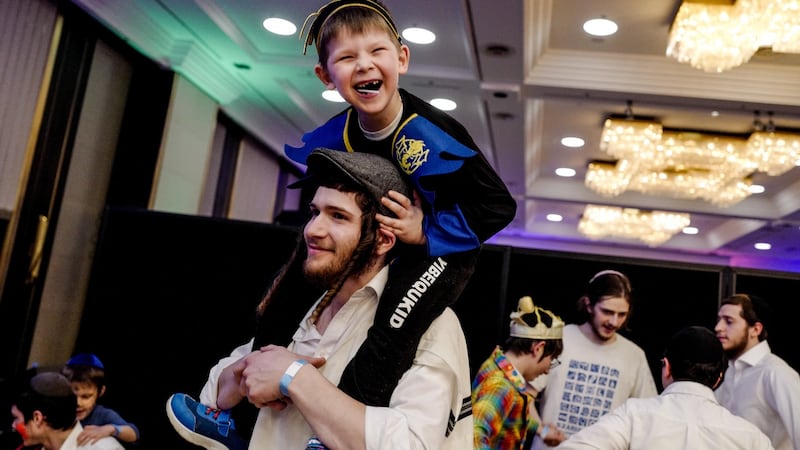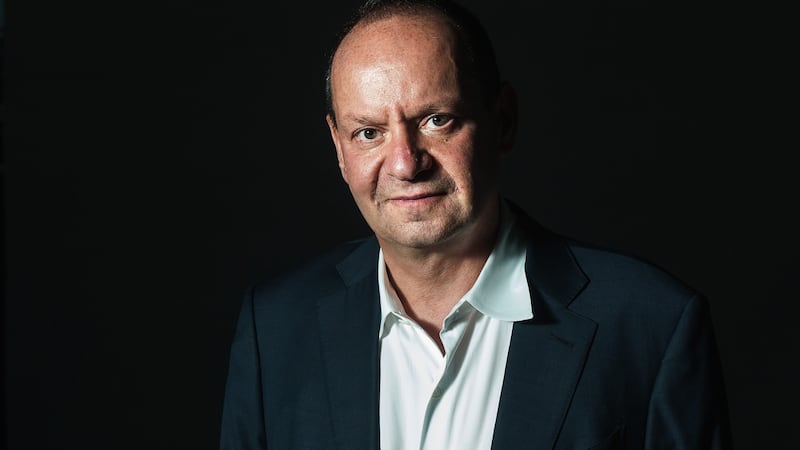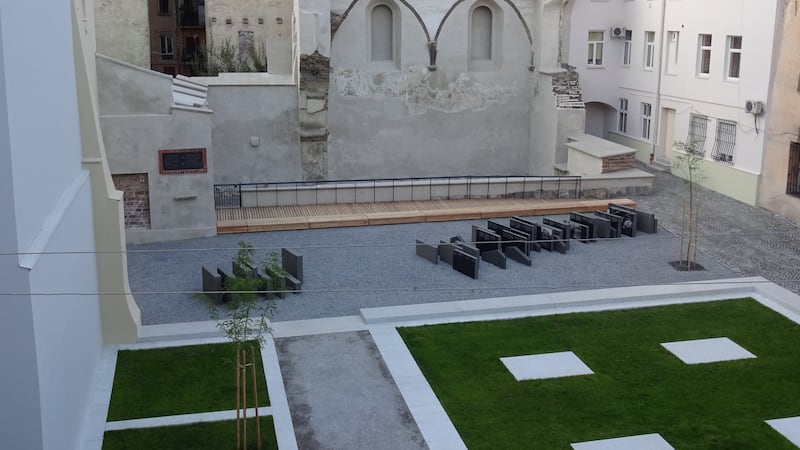Trains speed over the railway bridge, carrying their daily cargo of suffering refugees from the east to Lviv station. Eighty years ago, Jews travelled the same tracks to extermination camps in Poland.
First they were herded on to this scraggly plot of land, passing beneath this same railway bridge. It was called Peltewna then, and was known as the bridge of death.
A clogged four-lane highway, then Peltewna Street, now rechristened Chornovola, runs alongside the memorial plot. “Through this road of death in 1941-1943 were passing 136,800 Jewish victims martyred by German Nazi-Fascist occupiers in Lvov ghetto,” is engraved on a stone.
Lvov is the Polish and Russian name for the western Ukrainian city Lviv, which is called Lemberg in German.
The Centre for Urban History of East Central Europe estimates the number of Jews in Lviv during the second World War to have been somewhat higher.
"When the war started, there were 100,000 Jews in Lviv, more than a third of the population," says Sofia Dyak, a leading historian and director of the centre.
In 1939, as in 2022, Lviv was seen as a place of refuge. “Tens of thousands of Polish Jews fled to Lviv when the Nazis invaded Poland,” Dyak continues. “No one knew yet about the Holocaust, but the Nazis were clearly anti-Semitic and the Kristallnacht [pogrom in 1938] had occurred. The Jewish population of Lviv swelled to about 160,000.”
What is the point of saying 'never again' for 80 years, if the world stays silent when a bomb drops on the same site of Babyn Yar?
Of those, fewer than 1,000 survived. The rest worked and died in the nearby Janowska labour camp, were shot at the Piaski ravine or sent by train to the gas chambers of Belzec.
Unspeakable cruelty
It was a process of unspeakable barbarity. The Nazis forced an orchestra comprising Jewish inmates at Janowska to play the Tango of Death during hangings, the foxtrot during torture sessions. On the eve of the camp’s liberation by Soviet forces, camp guards arranged the musicians in a circle, then took them, one by one, to the centre, and ordered them to lay down their instruments and strip naked before shooting them in the head.

Since Russia invaded Ukraine on February 24th, the second World War has been ever present, in the speeches of Vladimir Putin, but also in video addresses by Ukrainian president Volodymyr Zelenskiy, and in countless daily conversations.
On March 1st, Russian missiles damaged the memorial at Babyan Yar, the ravine in Kyiv where, in September 1941, the Nazis assembled tens of thousands of Jews, 33,771 by the Nazis' own record-keeping, and shot them dead over two days. The ravine would become a mass grave for about 100,000 people, including Ukrainian civilians, Roma and Soviet prisoners as well as Jews.
“What is the point of saying ‘never again’ for 80 years, if the world stays silent when a bomb drops on the same site of Babyn Yar? At least 5 killed. History repeating . . .” Zelenskiy tweeted.
The crimes and rhetoric of this war see-saw constantly between the present and 1939-1945.
Boris Romanchenko (96) died in the eastern city of Kharkiv this month when a Russian missile hit his apartment building. He had survived three Nazi concentration camps and every year attended the commemoration of the liberation of Buchenwald.
Meaningful lives
At the opposite end of Ukraine, in Lviv, Boris Dorfman (98), who had also evaded death at the hands of the Nazis, died of natural causes. Both men had gone on to lead engaged and meaningful lives. Both were deeply distressed by the Russian invasion. "It is starting again," they told friends.
There is a major difference, however. “In 1939, people here saw the German army advancing and they asked who would help them,” Dyak says. “Ukraine is in a better world, because of the previous war. The moral reference is much stronger. In Lviv, people were trapped because they were attacked from the east and from the west. Now we are attacked from the east, but more than 3.5 million Ukrainians have been able to flee to EU countries.

“You do not feel so alone,” Dyak continues. “There is much more solidarity. We are not trapped, though there is a sense of an existential threat.”
Galicia, the Austro-Hungarian province comprising southeastern Poland and western Ukraine, was the cradle of ultra-Orthodox Hasidic Judaism in the 18th century. The Jews of the region endured pogroms during Tsarist rule, extermination by the Nazis and persecution under Stalin.
Yet Lviv thrived as an intellectual centre. As recounted in Philippe Sands’s book East West Street: On the origins of Genocide and Crimes Against Humanity, two concepts pertinent to the present war originated with Jewish lawyers at the University of Lviv.
Raphael Lemkin invented the word genocide to define the attempted annihilation of an entire ethnic group or race of people. Hersch Lauterpacht helped to prosecute Nazis who committed crimes against humanity – Lauterpacht's formulation – at the Nuremberg trials.
“Why did Lauterpacht and Lemkin do what they did?” asks Sands, a British lawyer and writer. “If they had been born in New York or London or Dublin, I think it is less likely they would have had these pioneering ideas. They were deeply affected by the environment in which they lived, where different communities struggled to live together. That is essentially what today’s conflict is about . . . The roots of what is happening today are the same roots that inspired Lauterpacht and Lemkin. I think there is a deep connection.”
Putin’s revanchism
Much of 20th-century intellectual thought focused on “how to be diverse and multicultural in a peaceful way”, Dyak says. Putin’s assault on Ukraine has shown the limits of that exercise. Dyak believes the denouement of the cold war is one reason. “In every victory there is a seed of future defeat . . . The transformation of the [post-Soviet] 1990s was brutal here, in Russia, in the whole eastern bloc.”
In other words, Putin's Russian revanchism is rooted in the cold war defeat of the Soviet Union, just as Hitler rose to power in the wake of the Treaty of Versailles. "The feeling of injustice is a great fuel," Dyak says.
Putin is reportedly transferring thousands of civilians from eastern Ukraine to Russia. Mass deportations are also a throwback to past wars. “What do you do with border areas where you have a mixed population?” Dyak asks. “The policy was officially called ‘population exchange’ and it was thought of as a way of solving inter-ethnic tensions.”
The philosophy behind the practice has been that the first generation of an uprooted population may suffer, but the second generation will no longer kill each other.

At the end of the second World War, Churchill, Roosevelt and Stalin agreed to mass transfers of populations in central and eastern Europe. The Soviet Union forcibly displaced millions of Poles from western, Soviet Ukraine to Poland.
'This is not just the continuation of the second World War,' he says. 'It's the entire 20th century'
In December 1944, Churchill advocated the deportation of German populations from eastern Europe in the House of Commons: “Expulsion is the method which, so far as we have been able to see, will be the most satisfactory and lasting. There will be no mixture of populations to cause endless trouble.”
Deportation as practised by Russia in eastern Ukraine is one of the possible war crimes under investigation by the International Criminal Court.
Francine Hirsch, a professor of Soviet and European history at the University of Wisconsin, recently tweeted a text by a Soviet prosecutor recounting German atrocities in Mariupol in 1944.
Martyred city
Mariupol is today Ukraine’s martyred city. “These are the lands in which these issues have been rehearsed,” Sands says. “That is why, I think, this war is resonating so deeply, and why it is causing so many people to feel we are on the cusp of a castrophe if we don’t sort this out.”
Sands’s own grandfather, then 10 years old, went through Lviv train station as he fled advancing Russian troops in 1914. “This is not just the continuation of the second World War,” he says. “It’s the entire 20th century. Lviv is a city which changed hands four times in the space of a single month in November 1918 . . . History just goes round and round. It’s the same underlying set of issues: Who are we? How do we live together?”
Ukraine's Jews are not targets in this war, but they endure the same danger as their fellow Ukrainians. Zelenskiy, the president, is Jewish. Defence minister Oleksiy Reznikov, from Lviv, is also Jewish. A Pew Research Centre poll in 2018 found Ukraine to be the most accepting of Jews among central and east European countries.
Moshe Reuven Azman, the chief rabbi of Kyiv, is sheltering refugees in his synagogue and helping with evacuations. For the Jewish holiday of Purim in mid-March, Azman posted a video on YouTube in which he walks out of his synagogue singing, "How can you not love my Kyiv?" Explosions sound in the background.
Israel has already received 17,000 refugees from the war in Ukraine, of whom at least one-third are Jews, the Financial Times reported on Sunday. The Jewish state expects up to 50,000 Ukrainian, Russian and Belorusian refugees within three months, possibly twice that many by the end of this year. Jewish refugees receive preferential treatment.
![Director of the Lviv Centre for Urban History Sofia Dyak: ‘In every victory there is a seed of future defeat . . . The transformation of the [post-Soviet] 1990s was brutal here, in Russia, in the whole eastern bloc.’ Photograph: Ovsyannikova Yulia/ Ukrinform/Future Publishing](https://www.irishtimes.com/resizer/v2/BOM6F5P4TAGUZSN7AWGFCKKU64.jpg?auth=5830bb224c25e43f286b922045c1d505e8ce8c2d154c2a737dcd62d28dedb218&width=800&height=450)
Yet Zelenskiy’s March 20th address to the Knesset offended many, starting with prime minister Naftali Bennett, by suggesting that Russia is carrying out a genocide against Ukraine.
The use of the term genocide is now hotly debated among historians, Dyak says, referring to The Problems of Genocide, Permanent Security and the Language of Transgression, a controversial book by the Australian historian Dirk Moses. Moses believes that "securitisation" – the perception, often ill-founded, that a specific people present a threat – rather than ethnic or racial hatred, is the root cause of mass killings of civilians by powerful countries. Putin's onslaught against Ukraine seems to fit Moses's theory.
Jewish victims
Dyak gives me a guided tour of the Space of Synagogues, a memorial square in Lviv’s old city which she co-curated. It contains the ghostly outlines of two synagogues from the 16th and 19th centuries which were dynamited by the Nazis in 1943.
Quotations from Jewish victims of the Holocaust were engraved on granite markers in the Space of Synagogues, by consensus of co-sponsors of the project. The quotes range from the intensely personal to the universal. Several are deeply moving and have resonance in today’s war.
“Life was no longer normal, it was in no way reminiscent of life before the outbreak of war,” Ignacy Chiger wrote. “That recently wonderful world was about to plunge into DARKNESS.” Chiger and his family hid from the Nazis for 14 months in the sewers of Lviv, beneath the old town’s cobblestone streets, in appalling conditions.
The use of the quotations was the subject of heated negotiations. Though the issue of police collaboration is addressed in a plaque on the site, allusions to the involvement of Ukrainians and Poles in the arrest of Jews were elided from two quotations. In one instance, a leader of the present-day Jewish community threatened to sue on the grounds that mentioning their participation would “instigate inter-ethnic animosity”.
Eighty years after the Holocaust, “we can have a conversation about collaboration, but it is a hard conversation”, Dyak says.
For example, Inka Katz, Lauterpacht's niece, told Sands of the day her mother was taken away by Germans and Ukrainians. Sands contributed the quote to the Space of Synagogues project. "I saw everything looking out of the window. I was 12. I wasn't a child any more . . . I saw my father running after my mother, behind her, on the street. I understood it was over. I knew what was happening. I can still visualise the scene, my mother's dress, her high heels . . ."
The words “taken away by Germans and Ukrainians” were excised from Katz’s quote by the committee.
‘Righteous gentiles’
Ukraininan involvement in the second World War persecution of Jews is an irritant between Kyiv and Israel, along with the question of proprietorship of the word “genocide”. Zelenskiy alluded to the 2,500 Ukrainians who have been declared “righteous gentiles” by Israel, for helping to save Jews from the Nazis.
I am not saying there is no anti-Semitism in Ukraine. It is, alas, present in every European society
But far more Ukrainians were accused of collaborating; approximately 500,000, according to Dyak. “It ranged from killing Jews to simply working for local authorities,” she explains. “On the other hand, three million Ukrainians fought with the Red Army against the Nazis.”
When he was making My Nazi Legacy, a documentary about the sons of Nazi war criminals, Philippe Sands attended a commemoration of the creation of the Waffen SS Galicia Division in western Ukraine.
“To see hundreds of people dancing around in Nazi uniforms and supporting that was deeply, deeply distressing,” Sands says. “But it’s a minority and this idea of the de-Nazification of Ukraine is outrageous. Putin is digging into those memories of the 1930s and 1940s and he is using them for really malign purposes.”
Accusations of neo-Nazism and anti-Semitism have been levelled at the small Svoboda party and at the Azov Battalion which is defending Mariupol.
“Anti-Semitism is not at the core of their ideology,” says Dyak. “One far-right politician was elected to parliament in the last election, and he stood as an independent . . . I am not saying there is no anti-Semitism in Ukraine. It is, alas, present in every European society. We are constantly thinking about how to educate people.”
As Dyak and I leave the Space of Synagogues, I spot a large swastika scrawled in black marker on a wall of the memorial square. “That’s a new one,” the historian sighs. “I will call the municipality. It will be cleaned. I don’t know when though.”
For there’s a war on, again. Air raids sirens wail through much of the day and night. The municipality has other priorities.











